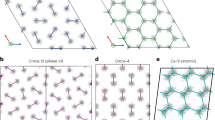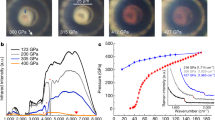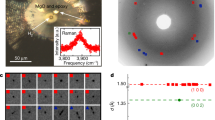Abstract
More than six decades have passed since Wigner and Huntington1 proposed that hydrogen might form a solid metallic phase at high density with characteristics similar to the alkali metals. This possibility has been investigated using the diamond-anvil cell to compress the crystalline state of molecular hydrogen2, but there is still no definitive evidence for a dense, low-temperature metallic state. Below 140 K, solid hydrogen undergoes a transition at about 1.5 million atmospheres between two orientationally ordered states. The intermolecular vibrational mode (the vibron) shifts to a lower frequency at this transition3,4, and becomes strongly infrared-active5. So far as is known, hydrogen remains in this phase to the highest pressures yet reached. Here we report first-principles calculations of the structure of this phase using electronic density-functional theory. We find that it develops a spontaneous polarization at around ninefold compression relative to the volume at 1 atmosphere and that there is a corresponding movement of proton pairs away from their ideal lattice sites. Such behaviour can explain why the vibron becomes infrared-active, and rationalizes the direction and mass-dependence (in experiments on deuterium) of the shift of the vibron frequency. In the polarized state, the previously decreasing bandgap widens again, and so its appearance might delay the transition to the elusive metallic state.
This is a preview of subscription content, access via your institution
Access options
Subscribe to this journal
Receive 51 print issues and online access
$199.00 per year
only $3.90 per issue
Buy this article
- Purchase on Springer Link
- Instant access to full article PDF
Prices may be subject to local taxes which are calculated during checkout



Similar content being viewed by others
References
Wigner, E. & Huntington, H. B. On the possibility of a metallic modification of hydrogen. J. Chem. Phys. 3, 764–770 (1935).
Hemley, R. J. & Mao, H. K. in Elementary Processes in Dense Plasmas (eds Ichimaru, S. & Ogata, S.) 271–282 (Addison Wesley, Reading, MA, 1995).
Hemley, R. J. & Mao, H. K. Phase transition in solid molecular hydrogen at ultrahigh pressures. Phys. Rev. Lett. 61, 857–860 (1988).
Lorenzana, H. E., Silvera, I. F. & Goettel, K. A. Evidence for a structural phase transition in solid hydrogen at megabar pressures. Phys. Rev. Lett. 63, 2080–2083 (1989).
Hanfland, M., Hemley, R. J. & Mao, H. K. Novel infrared vibron absorption of solid hydrogen at megabar pressures. Phys. Rev. Lett. 70, 3760–3763 (1993).
Luttinger, J. M. & Tisza, L. Theory of dipole interactions in crystals. Phys. Rev. 70, 954–964 (1946).
Herzfeld, K. F. On atomic properties which make an element a metal. Phys. Rev. 29, 701–705 (1927).
Goldhammer, D. A. Dispersion und Absorption des Lichtes (Teubner, Leipzig, 1911).
Teter, M. P., Payne, M. C. & Allan, D. C. Solution of Schrödinger's equation for large systems. Phys. Rev. B 40, 12255–12263 (1989).
Kaxiras, E. & Broughton, J. Energetics of ordered structures in molecular hydrogen. Europhys. Lett. 17, 151–155 (1992).
Nagara, H. & Nakamura, T. Stable phases of solid hydrogen at megabar pressures and at zero temperature. Phys. Rev. Lett. 68, 2468–2471 (1992).
Mazin, I. I. et al. Quantum and classical orientational ordering in solid hydrogen. Phys. Rev. Lett. 78, 1066–1069 (1997).
Overhauser, A. W. Exchange and correlation instabilities of simple metals. Phys. Rev. 167, 691–698 (1968).
Pauling, L. The rotational motion of molecules in crystals. Phys. Rev. 36, 430–443 (1930).
Stern, T. E. The symmetric spherical oscillator and the rotational motion of homopolar molecules in crystals. Proc. R. Soc. Lond. A 130, 551–557 (1931).
Yin, M. T. & Cohen, M. L. Microscopic theory of the phase transformation and lattice dynamics of Si. Phys. Rev. Lett. 45, 1004–1007 (1980).
Mazin, I. I. & Cohen, R. E. Insulator-metal transition in solid hydrogen: Implications of electronic-structure calculations for recent experiments. Phys. Rev. B 52, R8597–R8600 (1995).
Edwards, B., Ashcroft, N. W. & Lenosky, T. Layering transitions and the structure of dense hydrogen. Europhys. Lett. 34, 519–524 (1996).
Baranowski, B. Ahypothesis concerning the low temperature phase transition in solid hydrogen and deuterium at about 150 GPa. Polish J. Chem. 66, 1737–1740 (1992).
Chen, N., Sterer, E. & Silvera, I. F. Extended infrared studies of high pressure hydrogen. Phys. Rev. Lett. 76, 1663–1666 (1996).
Cui, L., Chen, N. H. & Silvera, I. F. Excitations, order parameters, and phase diagram of solid deuterium at megabar pressures. Phys. Rev. B 51, 14987–14997 (1995).
Acknowledgements
We thank M. Teter (Cornell Univ. and Corning Inc.) and D. Allan (Corning Inc.) for use of the Corning LDA program and for many discussions. We also thank R. J. Hemley for discussions of his experimental results.
Author information
Authors and Affiliations
Corresponding author
Rights and permissions
About this article
Cite this article
Edwards, B., Ashcroft, N. Spontaneous polarization in dense hydrogen. Nature 388, 652–655 (1997). https://doi.org/10.1038/41727
Received:
Accepted:
Issue Date:
DOI: https://doi.org/10.1038/41727
This article is cited by
-
Boron charged under pressure
Nature (2009)
-
Ionic high-pressure form of elemental boron
Nature (2009)
-
The element of uncertainty
Nature (2000)
-
Structure and bandgap closure in dense hydrogen
Nature (2000)
-
Quantum distribution of protons in solid molecular hydrogen at megabar pressures
Nature (2000)
Comments
By submitting a comment you agree to abide by our Terms and Community Guidelines. If you find something abusive or that does not comply with our terms or guidelines please flag it as inappropriate.



